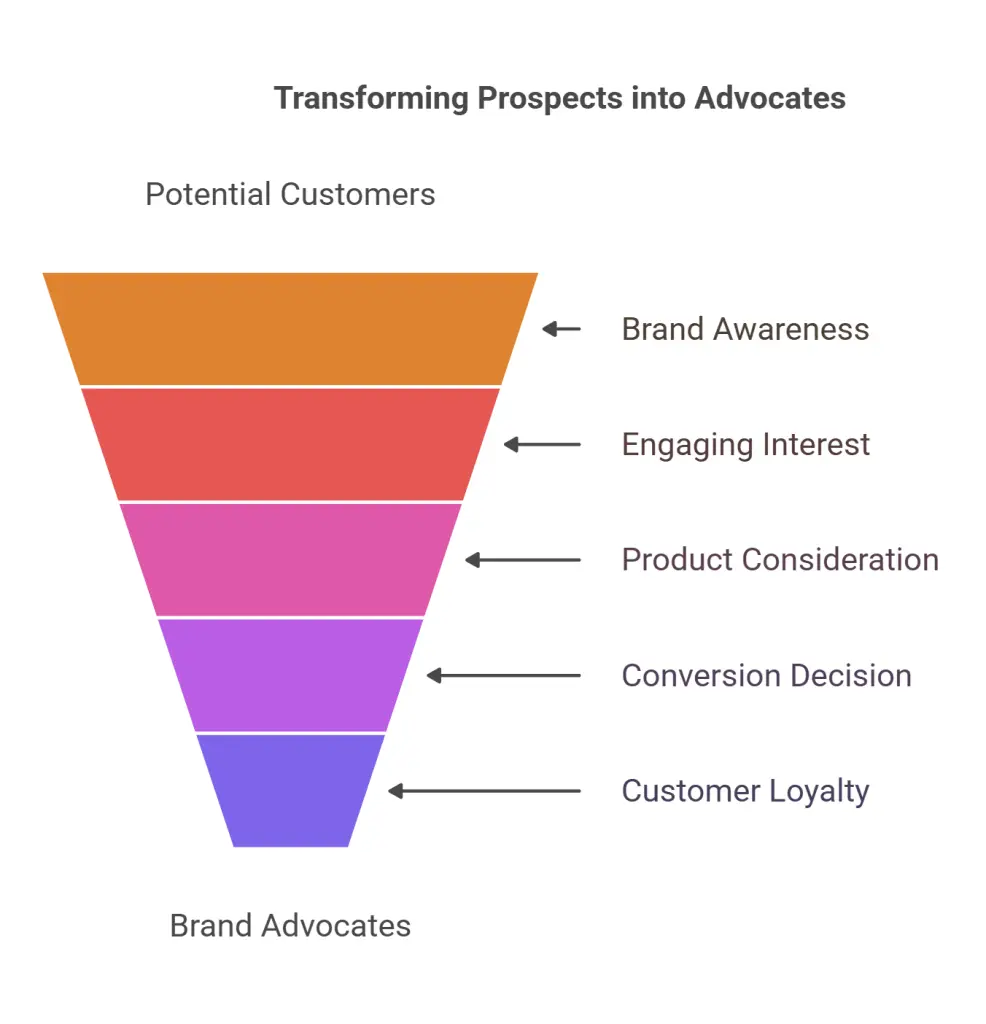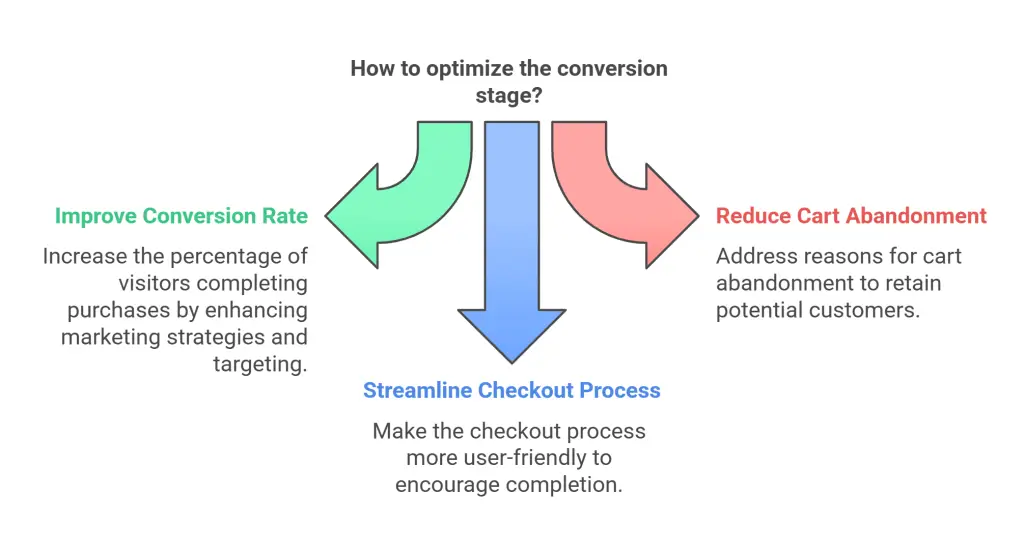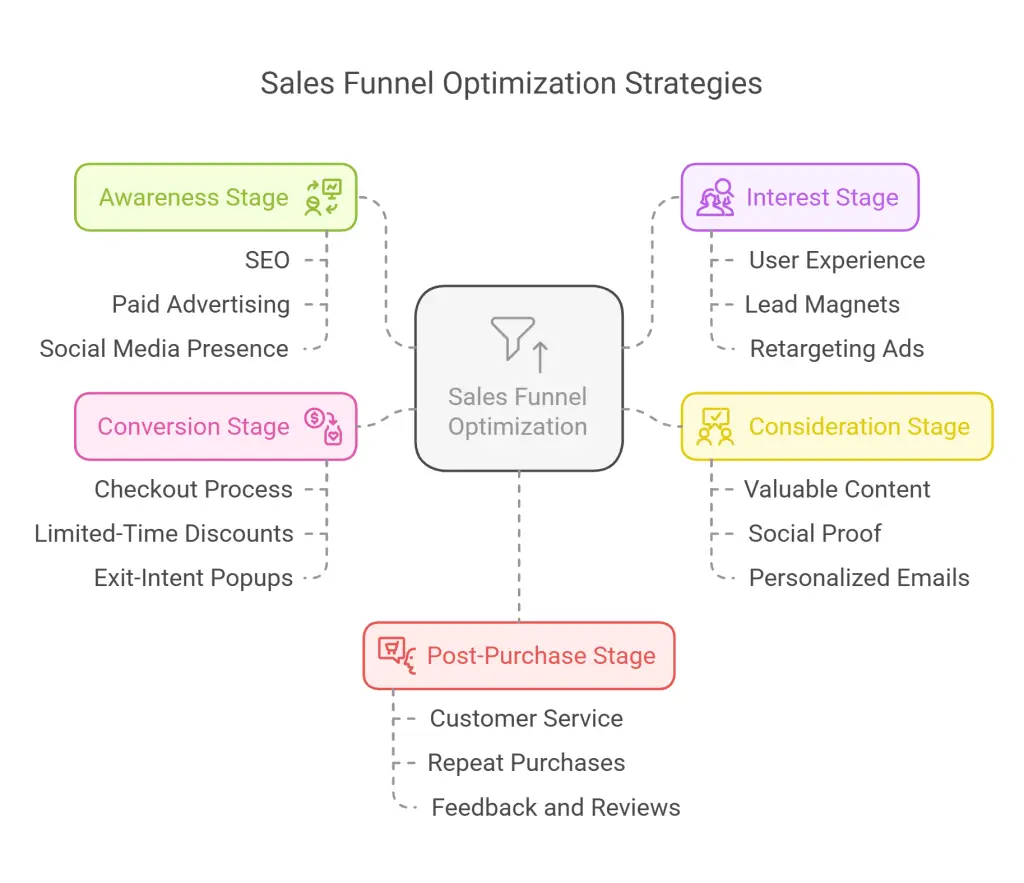A well-designed and optimized sales funnel is one of the most critical elements for driving online sales. It provides a structured path for guiding potential customers from the first interaction with your brand to a final conversion. However, many businesses struggle to maximize their sales funnel’s effectiveness, often due to a lack of understanding or analysis of how each stage performs.
In this guide, we’ll dive into what a sales funnel is, why it’s crucial to analyze it, where to focus your analysis, and when to make adjustments. You’ll also gain actionable steps for optimizing your sales funnel to increase conversions and grow your online business.
What is a Sales Funnel?
A sales funnel represents the journey a customer takes from the moment they first encounter your brand to the point of purchase. The concept visualizes the process as a funnel because it starts with a broad pool of potential customers and gradually narrows down to those who convert into paying customers.
Stages of the Sales Funnel
Understanding the different stages of the funnel is key to knowing where to focus your efforts. The sales funnel is typically broken down into the following stages:
- Awareness (Top of the Funnel – TOFU):
- This is where potential customers first discover your brand. They might come across your content through search engines, social media, or advertisements. The goal here is to attract as much relevant traffic as possible.
- Interest (Middle of the Funnel – MOFU):
- Once you have caught their attention, the next step is to engage them. At this stage, prospects may sign up for newsletters, read blog posts, or download resources, signaling their interest in your products or services.
- Consideration:
- In this phase, prospects evaluate your offerings more closely. They may compare your products to competitors, read reviews, and weigh the pros and cons before making a purchasing decision.
- Conversion (Bottom of the Funnel – BOFU):
- At this stage, the prospect decides to buy. This could be completing a purchase, signing up for a service, or taking another action that leads to a conversion.
- Loyalty/Retention:
- After the initial purchase, the relationship doesn’t end. The goal is to turn one-time buyers into repeat customers by providing excellent service and maintaining communication.
- Advocacy:
- Your most loyal customers can become advocates who promote your brand through word of mouth, reviews, and referrals.

Why Analyze Your Sales Funnel?
Sales funnels are complex systems, and if not properly maintained, they can become inefficient and fail to convert potential customers. This is why regular analysis is crucial.
Key Benefits of Sales Funnel Analysis
- Identifying Bottlenecks:
- By analyzing your sales funnel, you can identify stages where prospects drop off. Are you losing leads during the interest stage? Are many abandoning their carts? Pinpointing these issues allows for targeted improvements.
- Improving Conversion Rates:
- Optimization allows you to convert more leads at each stage, meaning you can increase your sales without needing to drive additional traffic to your site.
- Enhanced Customer Experience:
- Understanding how customers move through your funnel allows you to cater your messaging, design, and offers to meet their needs, improving their overall experience with your brand.
- Informed Decision-Making:
- With a clear view of how your sales funnel is performing, you can make data-driven decisions on where to allocate resources and adjust strategies to maximize ROI.

Where to Focus Your Sales Funnel Analysis?
Not all parts of the sales funnel are equally important to every business, and knowing where to focus your analysis is crucial to making meaningful improvements. Below are the key areas to prioritize during your analysis.
1. Awareness Stage: Traffic and Reach
At the top of your funnel, focus on how effectively you’re driving traffic to your website or landing pages.
- Key Metrics to Track:
- Traffic Sources (e.g., organic search, paid ads, social media)
- Impressions and Click-Through Rates (CTR)
- Website Visits and Unique Visitors
- Analysis Questions:
- Which sources are driving the most traffic?
- Are my ads or content resonating with the right audience?
- Is my website attracting qualified leads?

2. Interest Stage: Engagement
Once you have traffic, you need to measure how well you’re engaging visitors and encouraging them to stay connected with your brand.
- Key Metrics to Track:
- Bounce Rate (the percentage of visitors who leave after viewing just one page)
- Time on Site and Pages per Session
- Newsletter Signups or Resource Downloads
- Analysis Questions:
- Is my content engaging enough to keep visitors on my site?
- How well are my lead magnets performing?
- Are visitors signing up for further communication?

3. Consideration Stage: Nurturing Leads
At this stage, prospects are actively considering your product or service. Your goal is to nurture these leads with relevant content and offers.
- Key Metrics to Track:
- Email Open and Click Rates
- Social Proof Interactions (e.g., reviews, testimonials)
- Return Visits and Further Engagement
- Analysis Questions:
- Are my emails effectively driving engagement?
- Is social proof (reviews, testimonials) helping to build trust?
- Are prospects returning to my site for more information?

4. Conversion Stage: Purchase Behavior
The conversion stage is critical because this is where prospects become paying customers.
- Key Metrics to Track:
- Conversion Rate (the percentage of visitors who complete a purchase)
- Cart Abandonment Rate
- Checkout Process Completion Time
- Analysis Questions:
- What percentage of leads are converting into sales?
- Why are prospects abandoning their carts?
- Is my checkout process user-friendly?

5. Post-Purchase Stage: Customer Retention
Even after a sale, there’s room for analysis and optimization to build long-term loyalty.
- Key Metrics to Track:
- Customer Satisfaction Scores (e.g., NPS)
- Repeat Purchase Rate
- Customer Lifetime Value (CLV)
- Analysis Questions:
- Are customers satisfied with their purchase?
- How many first-time buyers come back for more?
- Is my post-purchase communication effective in building loyalty?

When to Review and Adjust Your Sales Funnel?
The frequency and timing of sales funnel reviews depend on the size of your business and the pace at which you operate. However, there are several key moments when funnel analysis is especially crucial.
Critical Times to Review Your Funnel
- After Major Campaigns or Product Launches:
- Whenever you launch a new product, service, or marketing campaign, it’s essential to monitor how prospects are moving through the funnel.
- Quarterly or Bi-Annually:
- Routine analysis every quarter or twice a year helps you stay proactive and adjust to changes in customer behavior or market trends.
- When Sales Drop:
- A sudden dip in sales is often a red flag that something is wrong with your funnel. Conduct an analysis to identify and address any issues promptly.
- After Significant Business Changes:
- If you’ve rebranded, redesigned your website, or introduced new products, review your funnel to ensure that everything is functioning as expected.

Steps to Optimize Your Sales Funnel for Increased Conversions
Now that we’ve covered what a sales funnel is, why it’s important to analyze it, and when to review it, let’s explore actionable strategies to optimize each stage for increased conversions.
1. Optimizing the Awareness Stage
- Leverage SEO:
- Ensure that your website and content are fully optimized for search engines. Invest in keyword research to target terms your audience is searching for and create high-quality content to increase organic traffic.
- Enhance Paid Advertising:
- Utilize targeted ads on platforms like Google and Facebook to reach your ideal audience. Test different ad creatives, headlines, and calls-to-action (CTAs) to improve your CTR and drive more qualified leads.
- Expand Your Social Media Presence:
- Develop a robust social media strategy that engages users and encourages them to visit your website. Share content that is not only promotional but also educational or entertaining to attract a wider audience.
2. Optimizing the Interest Stage
- Improve Your Website’s User Experience (UX):
- A smooth and intuitive user experience is essential to keep visitors on your site. Ensure that your site is fast, easy to navigate, and mobile-friendly.
- Create Compelling Lead Magnets:
- Offer valuable resources, such as eBooks, guides, or webinars, in exchange for visitors’ email addresses. These lead magnets should address your audience’s pain points and demonstrate the value of your product or service.
- Use Retargeting Ads:
- Use retargeting ads to keep your brand top-of-mind for visitors who didn’t convert on their first visit. These ads can serve as reminders, bringing prospects back to your site to engage further.
3. Optimizing the Consideration Stage
- Provide Valuable Content:
- Create content that helps prospects make informed decisions. This could include comparison guides, product demos, and case studies that showcase the benefits of your offerings.
- Incorporate Social Proof:
- Display customer reviews, testimonials, and case studies prominently on your site. Social proof can alleviate concerns and help prospects feel more confident in their decision to choose your product or service.
- Nurture Leads with Personalized Emails:
- Use email marketing to nurture leads by sending them personalized content based on their behavior, preferences, and stage in the funnel. Tailor your messages to address their specific needs and concerns.
4. Optimizing the Conversion Stage
- Simplify the Checkout Process:
- Reduce friction by making your checkout process as simple and user-friendly as possible. Minimize the number of steps, offer guest checkout options, and ensure that your site is secure and trustworthy.
- Offer Limited-Time Discounts:
- Create a sense of urgency by offering time-sensitive discounts or promotions. This can encourage hesitant buyers to make a decision more quickly.
- Use Exit-Intent Popups:
- If a user is about to leave your site without converting, trigger an exit-intent popup with a special offer or reminder. This can help capture lost conversions at the last moment.
5. Optimizing the Post-Purchase Stage
- Deliver Exceptional Customer Service:
- Ensure that your customers have a positive post-purchase experience by providing excellent customer support. Prompt responses to inquiries and helpful follow-ups can make a big difference in customer satisfaction.
- Encourage Repeat Purchases:
- Use post-purchase emails to recommend related products or offer discounts on future purchases. Loyalty programs and personalized offers can help turn one-time buyers into repeat customers.
- Ask for Feedback and Reviews:
- After a purchase, request customer feedback and reviews. Not only can this help improve your business, but it also provides you with valuable social proof for future prospects.

Conclusion
Optimizing your sales funnel is a continuous process that can significantly boost your online sales. By regularly analyzing each stage of the funnel, identifying areas for improvement, and implementing targeted strategies, you can drive more prospects through the funnel and increase your conversion rates. Remember that the key to a successful funnel is understanding your customers’ journey and creating a seamless, personalized experience at every touchpoint.
Further reading
Salesforce. “What Is a Sales Funnel?” Last accessed February 4, 2025. https://www.salesforce.com/au/blog/sales-funnel/.
Keap. “Sales Funnel: How It Works with Keap.” Last accessed February 4, 2025. https://keap.com/product/sales-funnel.
HubSpot. “The Ultimate Guide to Sales Funnels.” Last accessed February 4, 2025. https://blog.hubspot.com/sales/sales-funnel.
YouTube. “Understanding the Sales Funnel.” Last accessed February 4, 2025. https://www.youtube.com/watch?v=VHpxteIrdk8.
Pipedrive. “What Is a Sales Funnel and How to Build One.” Last accessed February 4, 2025. https://www.pipedrive.com/en/blog/sales-funnel.
Shopify. “Sales Funnel: A Guide for E-commerce Businesses.” Last accessed February 4, 2025. https://www.shopify.com/au/blog/sales-funnel.
TechTarget. “Sales Funnel Definition.” Last accessed February 4, 2025. https://www.techtarget.com/searchcustomerexperience/definition/sales-funnel.
LinkedIn. “Sales Funnel: Definition and Stages.” Last accessed February 4, 2025. https://business.linkedin.com/sales-solutions/resources/sales-funnel-definition-and-stages.







